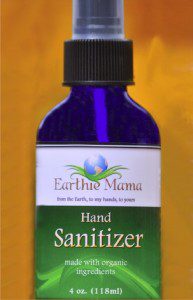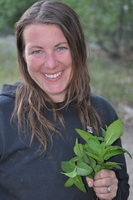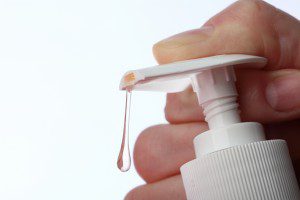By Alex ‘Earthie Mama’ Du Toit
Guest writer for Wake Up World
Fact: Commercial hand sanitizers are chemically-scented and made with toxic ingredients. While, yes, they do kill certain bacteria and viruses, the unfortunate byproduct is that these chemicals also seep into the pores of the skin and are absorbed into the bloodstream.
The primary active ingredients in commercial sanitizers are Ethyl alcohol and Isopropyl alcohol. [1] Isopropyl alcohol is a petrochemical that is commonly used as an industrial solvent. It is a well-known neurotoxin, meaning it is toxic to the human brain and nervous system. [2] Ethyl alcohol, also known as ethanol, is both neurotoxic and psychoactive. [3]
Thankfully there are natural sanitizer alternatives that can help keep you and your children’s hands clean and germ-free, without damaging your nervous system in the process. And today I’m going to share with you two simple recipes I came up with that are effective and very easy to make at home! The first one is a gel and the other one is a spray. They both work great, it just depends on your preference.
[pro_ad_display_adzone id=”110028″]
But first, the “dirty” truth…
Just like the muscles in our body, the immune system needs to be exercised in order to fully develop and become strong enough to resist illness and disease. Research into the connection between getting dirty and immune system health has found that our society’s modern obsession with germs and cleanliness might be leading to the rise in allergies [4], asthma and inflammatory bowel disease. [5]
If appropriate immune tolerance is not established in early life and maintained throughout life, this represents a risk factor for the development of inflammatory, autoimmune, and allergic diseases. Early-life events are instrumental in establishing the microbiota… [which] protect against systemic inflammatory disease pathologies. [4]
Put simply, eating dirt as a child is actually the ideal training to build your immune system’s overall fitness. (For more information, please see my recent article: Dirt is NOT Dirty – How Playing in the Dirt Benefits the Immune System.)
But, when playtime is over, it’s time to clean up! I really wanted my children to be able to keep their hands clean, particularly at school, but knowing there was no way I was going to use those toxic commercial brands. That’s when I decided to do some research and play around with some ingredients, and came up with these two simple recipes.
Both of these hand sanitizer recipes are great to keep handy because Each ingredient has many purposes besides just cleaning your hands. Not only do they act as a hand sanitizer, they also act as a natural antiseptic which is a great way to help the healing process for cuts and scrapes.
The Tea Tree and Lavender essential oils are known for their anti-bacterial and anti-fungal properties, which help to fight germs and infections. [6][7] The Witch Hazel is an anti-inflammatory and anti-microbial agent commonly used to treat minor itches, bruises, insect bites, minor burns, and other skin irritations. [8] Aloe Vera gel is incredibly healing to the skin [9] while Vitamin E oil helps to heal the skin while also serving as the natural preservative agent in these recipes. [10]
Gel Hand Sanitizer
Ingredients:
- 1 Tablespoon Witch Hazel
- 8 ounces 100% pure Aloe Vera gel
- 1/4 teaspoon Vitamin E oil
- 10 drops Tea Tree essential oil
- 5 drops Lavender essential oil
Directions:
- Mix together the essential oils and the Vitamin E in a container.
- Add Witch Hazel and mix.
- Add this mixture to the Aloe Vera gel and mix.
- Shake well before each use.
Storage:
This gel sanitizer should last a few months as the Vitamin E oil acts as a natural preservative. To help prolong the life of this blend, either re-use a squeezable or pump-top bottle or use a clean spoon to apply it straight out of a glass jar, rather than putting your dirty fingers into the mix each time you use it.
Spray Hand Sanitizer
Ingredients:
- 1 Tablespoon Witch Hazel
- 2 Teaspoons 100% pure Aloe Vera Gel (you can also use vegetable glycerin)
- 8 drops of Vitamin E oil
- Essential Oils (Lavender, Tea Tree, or try Lemon, Lime, Orange etc.)
- Clean Water
Directions:
- Combine together the witch hazel, aloe vera gel, Vitamin E oil, and essential oils.
- Pour into a small spray bottle.
- Add enough clean water to fill bottle.
- Shake well
Storage:
For this recipe you will need a 4 oz (120 ml) glass spray bottle, or similar. It is best not to use plastic as it may react with the essential oils.
An Easy Alternative
 If you don’t have the time to make these recipes yourself, or you can’t find all the ingredients to make them, you can buy my personal brand of hand sanitizer here. Made with the same ingredients above, my all-organic hand sanitizer is safe and effective to use on children and adults. From the Earth, to my hands, to yours!
If you don’t have the time to make these recipes yourself, or you can’t find all the ingredients to make them, you can buy my personal brand of hand sanitizer here. Made with the same ingredients above, my all-organic hand sanitizer is safe and effective to use on children and adults. From the Earth, to my hands, to yours!
If you try these recipes, please let me know how you like them. You can either comment below, or connect with me on Facebook.
To your health!
Alex (Earthie Mama)
References:
[1] Alcohol Hand Rub and Hand Hygiene. Clinical Excellence Commission, Health, New South Wales, Australia. www.cec.health.nsw.gov.au/programs/hand-hygiene
[2] Slaughter RJ, Mason RW, Beasley DM, Vale JA, Schep LJ (2014). “Isopropanol poisoning”. Clinical Toxicology 52 (5): 470–8.doi:10.3109/15563650.2014.914527. PMID 24815348.
[3] Brust, J. C. M. (2010). “Ethanol and Cognition: Indirect Effects, Neurotoxicity and Neuroprotection: A Review”. International Journal of Environmental Research and Public Health 7 (4): 1540–57. doi:10.3390/ijerph7041540.PMC 2872345. PMID 20617045.
[4] Rachel M. McLoughlin, PhD, Kingston H.G. Mills, PhD. Influence of gastrointestinal commensal bacteria on the immune responses that mediate allergy and asthma. Journal of Allergy and Clinical Immunology. DOI: http://dx.doi.org/10.1016/j.jaci.2011.02.012
[5] Malaty, Hoda M; Fan, Xiaolin; Opekun, Antone R; Thibodeaux, Carolyn; Ferry, George D. Rising Incidence of Inflammatory Bowel Disease Among Children: A 12-year Study http://journals.lww.com/jpgn/Fulltext/2010/01000/Rising_Incidence_of_Inflammatory_Bowel_Disease.11.aspx
[6] C. F. Carson, K. A. Hammer, and T. V. Riley. Melaleuca alternifolia (Tea Tree) Oil: a Review of Antimicrobial and Other Medicinal Properties. Clinical Microbiology Reviews. 2006 Jan; 19(1): 50–62. doi: 10.1128/CMR.19.1.50-62.2006
[7] Cavanagh HM, Wilkinson JM. Biological activities of lavender essential oil. Phytotherapy research. 2002 Jun;16(4):301-8.
[8] www.webmd.com/vitamins-supplements/ingredient…witchhazel
[9] B K Vogler, E Ernst. Aloe vera: a systematic review of its clinical effectiveness. www.ncbi.nlm.nih.gov/pmc/articles/PMC1313538. The British Journal Of General Practice. Br J Gen Pract. 1999 Oct; 49(447): 823–828.
[10] Nachbar F, Korting HC. The role of vitamin E in normal and damaged skin. Journal of Molecular Medicine. http://www.ncbi.nlm.nih.gov/pubmed/7633944. J Mol Med (Berl). 1995 Jan;73(1):7-17.
Recommended articles by Alex ‘Earthie Mama’ Du Toit:
- 7 Ingredients for Natural Cancer Prevention – Health Tonic Recipe Included!
- Treating Anxiety Naturally
- Immune Support Tonic – Delicious Natural Recipe
- Natural Antibiotic Ointment Recipe!
- Make Your Own Bug-Away Spray (Easy Recipe)
- Nature’s Most Powerful Antibiotics (Recipe Included!)
- 10 Health Benefits of Cucumbers
- Dirt is NOT Dirty – How Playing in the Dirt Benefits the Immune System
- How to Make Kombucha
- Practical Tips for Raising Earth-Conscious Children
- Homemade Ginger Ale Recipe
- Turmeric Milk Recipe: a Natural Mood Enhancer and Depression Fighter
About the author:
 Alexandra is a true Earthie Mama, helping others tune into their most natural, thriving state while bringing harmony and balance into all areas of their lives. She hosts a well-known blog, EarthieMama.com, where she writes about health and wellness, conscious parenting, green living, self sustainability and getting off the grid. Alex also has an MA in Psychology, and is a registered Yoga Instructor, environmentalist, conscious mother, green living advocate and natural birthing expert. She also sells all natural products and her ebooks through her website.
Alexandra is a true Earthie Mama, helping others tune into their most natural, thriving state while bringing harmony and balance into all areas of their lives. She hosts a well-known blog, EarthieMama.com, where she writes about health and wellness, conscious parenting, green living, self sustainability and getting off the grid. Alex also has an MA in Psychology, and is a registered Yoga Instructor, environmentalist, conscious mother, green living advocate and natural birthing expert. She also sells all natural products and her ebooks through her website.
Please check out her website at EarthieMama.com, connect with Earthie Mama on Facebook, or sign up to the free EarthieMama e-newsletter here!
[pro_ad_display_adzone id=”110027″]







